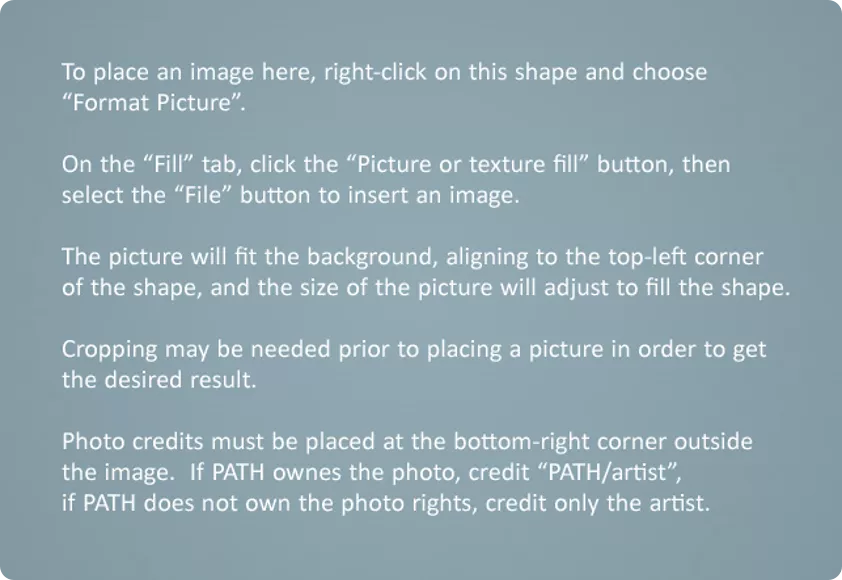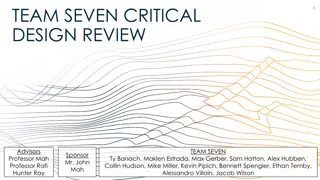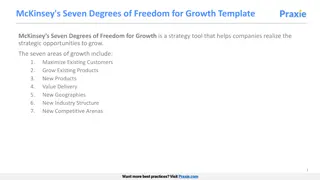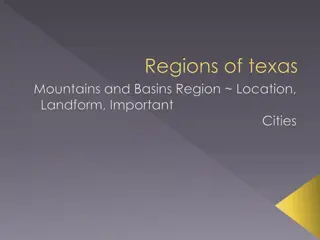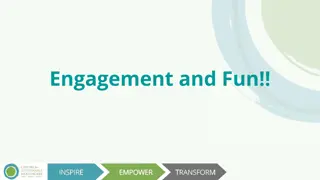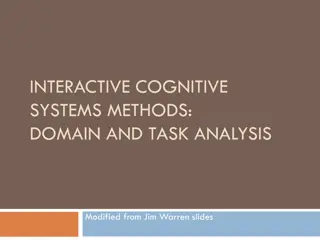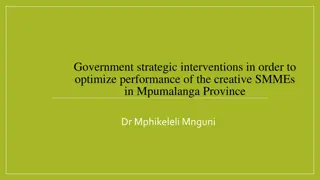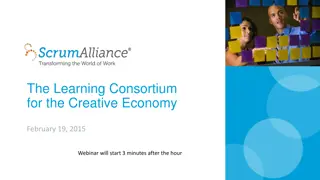Team Kermit - Seven Elements of Creative Course Design
Utilize brainstorming techniques to enhance student engagement and learning outcomes. Discuss strategies for integrating interdisciplinary perspectives, problem-based learning, and hands-on experiences in educational settings. Explore ways to motivate students through real-world challenges and small collaborative groups.
Download Presentation

Please find below an Image/Link to download the presentation.
The content on the website is provided AS IS for your information and personal use only. It may not be sold, licensed, or shared on other websites without obtaining consent from the author.If you encounter any issues during the download, it is possible that the publisher has removed the file from their server.
You are allowed to download the files provided on this website for personal or commercial use, subject to the condition that they are used lawfully. All files are the property of their respective owners.
The content on the website is provided AS IS for your information and personal use only. It may not be sold, licensed, or shared on other websites without obtaining consent from the author.
E N D
Presentation Transcript
Advocacy Impact for Health A Training of Facilitators Workshop [Insert date of workshop] [Insert location of workshop] Clockwise from Top Left: PATH/Monique Berlier, PATH/Mike Wang, PATH/Mike Wang, PATH/Satvir Malhotra
Training of Facilitators (TOF) objectives Explain the key elements of PATH s 10-part framework to developing a policy advocacy strategy. Understand and follow the instructions in the Advocacy Impact for Health Facilitator s Guide. Utilize effective facilitation techniques and instructional approaches to deliver the workshop. 2
Icons in the Facilitators Guide ? Read? from? a? PowerPoint? slide.? ? Use? a? flip? chart.? ? Lead? an? activity.? Deliver? this? key? point.? ? ? 5
Effective co-facilitation Only one lead facilitator for the session, while the other serves as the co-facilitator. Facilitator should lead a complete concept or session, and then exchange roles with co-facilitator. Use your co-facilitator to: Record information on a flip chart. Offer an additional perspective. Help answer a question. 6
Effective co-facilitation When serving as the co-facilitator: Allow the lead facilitator to manage the session flow. Trust that he/she has a plan. Don t jump in unless signaled to do so. Write on the flip charts so the lead facilitator can face the audience and keep dialogue flowing. Check in with each other during breaks and at the end of day. Establish cues for each other: I think we need a quick time-out. Help me explain this concept. 7
Effective table coaching Allow small groups to self-direct their own discussion. Observe groups from afar. Then subtly check-in to make sure they understand the concepts and are progressing correctly. Inject help or guidance only when needed, and then step away. Guide groups to think critically to discover their own answers. Watch for dominant personalities, and draw others out. Monitor the time, and keep groups focused and productive. 8
Teaching adults Adults have unique motivations, needs, and learning styles. Adults are autonomous and self-directed. Adults are goal-oriented. Adults prefer learning to be relevant and practical. Adults are sensitive to wasted time. Adults may feel anxious about activities where they might appear less competent. 9
Learning styles Observers: Watching, seeing, reading Listeners: Listening, hearing sounds Thinkers: Thinking, problem-solving, analyzing Doers: Doing, touching, practicing, and moving 10
Main facilitation techniques Brainstorming Facilitated discussions Using flip charts PowerPoint slides Discovery learning activities Role-plays Small group collaboration on worksheets 11
Facilitation techniques and learning styles Brainstorming Observers Facilitated discussions Using flip charts Listeners PowerPoint slides Discovery learning activities Thinkers Role-plays Small group collaboration on worksheets Doers 12
Qualities of an effective facilitator Stays flexible with the schedule Shows enthusiasm Requests and uses feedback Remains neutral Uses the wisdom in the room Always comes prepared Encourages critical thinking Is observant and responsive Asks open-ended questions Stays mindful of physical presence Creates a welcoming atmosphere Is eager for participants to learn 13
What is policy advocacy? STEP 1 Introduce the session objectives Define policy advocacy. Identify different types of policy change and policy implementation. Differentiate policy advocacy from other related concepts. STEP 2 Define policy advocacy Brainstorm what advocacy means. Provide definition of advocacy, and explain components. Brainstorm types of policies. STEP 3 Compare advocacy with similar concepts Lead flip chart exercise and group discussion to compare policy advocacy with similar concepts. 14
What is policy advocacy? Session Objectives After this session participants will be able to: Define policy advocacy. Identify different types of policy change and policy implementation. Differentiate policy advocacy from other related concepts. 15
Policy advocacy definition Policy advocacy is the deliberate process of informing and influencing decision-makers in support of evidence-based policy change and policy implementation, including resource mobilization. 16
Policy advocacy definition Policy advocacy is a deliberate process. It aims to inform and influence decision-makers. Policy advocacy seeks changes that are evidence-based. The ultimate goal of policy advocacy is to achieve a desired policy change or ensure that an existing policy is implemented. 17
Types of policy change and policy implementation Policy change can include: Elimination of a harmful policy. Updating or amending an existing policy. Developing a new policy. Allocating or committing resources within a budget. Policy implementation can include: Disseminating a policy. Enforcing a policy. Disbursing allocated funds appropriately. Demonstrating accountability for policy commitments and carrying out the provisions called for within policies. 18
Introduction to the 10 parts STEP 1 Introduce the session objective Identify the critical components of an advocacy strategy framework. STEP 2 Review the 10 parts Describe the main components of each part. STEP 3 Activity: Case study Review in small groups a case study to identify the 10 parts. STEP 4 Preparing to develop an advocacy strategy Discuss steps to take before beginning an advocacy strategy to help understand the policy landscape. 19
Part 1: Advocacy issue STEP 1 Introduce the session objectives Identify qualities of a good issue for advocacy. Evaluate potential issues for advocacy. STEP 2 What makes a good issue for policy advocacy? Brainstorm qualities of a good issue for advocacy. Review slide on the five criteria for a good issue. STEP 3 Activity: Group exercise Lead flip chart exercise (demonstrates worksheet Identifying Potential Advocacy Issues) to identify problems and root causes to select potential advocacy issues. 20
Part 1: Advocacy issue STEP 4 Activity: Small group work Complete the worksheet Identifying Potential Advocacy Issues. Debrief and discuss. STEP 5 Prioritizing issues for policy advocacy Brainstorm factors in choosing among issues. Show slides on criteria to evaluate potential advocacy issues. Lead flip chart exercise (demonstrates worksheet Choosing an Advocacy Issue) to evaluate potential advocacy issues. STEP 6 Activity: Small group work Complete the Choosing an Advocacy Issue worksheet to assess and select an advocacy issue. Debrief and discuss. 21
Part 1: Advocacy issue Session Objectives After this session participants will be able to: Identify qualities of a good issue for advocacy. Evaluate potential issues for advocacy. 22
A good issue for policy advocacy is A current objective or natural outgrowth of your program s work. Based in evidence. Readily improved with a policy change or implementation of an existing policy. Reasonably attainable in three to five years. Suitably specific and clear. 23
Criteria for prioritizing advocacy issues Specificity and clarity. Amount of evidence to prove the problem. Potential for partnership to address the issue. Amount of political will to address the issue. Organization has unique experience and expertise to contribute to addressing the issue. Availability of resources (time, money, and influence) to address the issue. Risk to your organization to address the issue. Likelihood the policy change or action will significantly impact the problem. Feasibility of success in three to five years. 24
Preparing for practice As you prepare, notice: Materials you will need. Sequence of steps. Key points you should make. Any flip charts you should prepare. Note any adjustments to timing written on your practice card. Instructions are not a script. Be flexible as the conversation unfolds. Be mindful of time allotted for your session, and try to stick to it. This is a practice. The goal is to become familiar with the content and practice key facilitation skills. 25
Facilitation practice guidelines Prepare your flip charts before you begin. Practice your time management skills. Use your co-facilitator. Take an active role as a workshop participant. Learn from and help each other. Have fun! 27
Giving helpful feedback Too general: You were good when Jonathon was going off topic. More specific: I liked how you asked Jonathon s permission to interrupt and gently suggested we write his comment in the Parking Lot to discuss later. I think he felt acknowledged, and you kept the process moving. 28
Part 2: Advocacy goal STEP 1 Introduce the session objectives Identify the essential components of an advocacy goal. Develop an advocacy goal for your strategy. STEP 2 Identify potential solutions Review the four elements of a policy advocacy goal. Help participants identify a policy advocacy solution the change they d like to see and the decision-making institution that could make the change. 29
Part 2: Advocacy goal STEP 3 Turn policy advocacy solutions into advocacy goals Lead flip chart exercise (demonstrates Identifying Potential Advocacy Goals worksheet) to develop a policy advocacy goal. STEP 4 Activity: Small group work Complete the worksheet Identifying Potential Advocacy Goals. Debrief and discuss. 30
Part 2: Facilitation practice STEP 1 Introduce the session objectives: Identify the essential components of an advocacy goal. Develop an advocacy goal for your strategy. STEP 2 Identify potential solutions Review the four elements of a policy advocacy goal. Help participants identify a policy advocacy solution. STEP 3 Turn policy advocacy solutions into advocacy goals Lead a flip chart exercise (demonstrates Identifying Potential Advocacy Goals worksheet) to develop a policy advocacy goal. STEP 4 Activity: Small group work Complete the worksheet Identifying Potential Advocacy Goals. Debrief and discuss. 31
Four elements of a policy advocacy goal WHO: the decision-making institution with the power to take action on your advocacy issue. WHAT: the change you would like to see relative to your advocacy issue. HOW: the specific action the decision-making institution can take to accomplish the change. WHEN: a time frame for the action to occur (often between six months and three to five years, depending on the particular advocacy effort). Page 32
Optional session: Developing an evidence dossier STEP 1 Introduce the session objective Learn how to create a dossier of the major evidence available to support your advocacy issue and goal. STEP 2 Compiling evidence for advocacy Brainstorm sources of evidence that may help in advocacy efforts. Discuss the importance of using evidence in advocacy. STEP 3 Review the worksheet Introduce participants to the worksheet Developing an Evidence Dossier, to be completed after the workshop. 33
Part 3: Decision-makers and influencers STEP 1 Introduce the session objectives Identify key decision-makers and influencers. Target advocacy goals to the appropriate decision-makers. STEP 2 Define and identify decision-makers Review slide to define decision-maker. Brainstorm examples of decision-makers and ways to reach them. 34
Part 3: Decision-makers and influencers STEP 3 Define and identify key influencers Review slide to define key influencers. Brainstorm examples of key influencers. STEP 4 Activity: Small group work Complete the worksheet Identifying Decision-makers. Complete the worksheet Identifying Influencers. Debrief and discuss . 35
Part 3: Facilitation practice STEP 2 Define and identify decision-makers Review slide to define decision-maker. Brainstorm examples of decision-makers and ways to reach them. STEP 3 Define and identify key influencers Review slide to define key influencers. Brainstorm examples of key influencers. STEP 4 Activity: Small group work Complete the worksheet Identifying Decision-makers. Complete the worksheet Identifying Influencers. Debrief and discuss. 36
Definition of decision-makers Decision-makers: People with the formal power or authority to take the desired policy action and/or their key advisors or staff. 37
Definition of influencers Key influencers: People or groups who can have a compelling force on the actions, opinions, or behavior of decision-makers. 38
Part 4: Decision-makers key interests STEP 1 Introduce the session objectives Evaluate the awareness and position of your key decision- makers on your issue and advocacy goal. Identify decision-makers key interests as a means to persuade them on your issue and advocacy goal. STEP 2 Awareness and position of decision-makers Review slides to explain the levels of awareness and various positions of decision-makers. Lead flip chart exercise to demonstrate the worksheet Identifying Decision-makers Key Interests. 39
Part 4: Decision-makers key interests STEP 3 Activity: Small group work Complete the worksheet Identifying Decision-makers Key Interests to identify the awareness, position, and key interests of their decision-makers. STEP 4 Activity: Getting sorted Lead a discovery learning activity to debrief the small group work. 40
Part 4: Facilitation practice STEP 2 Awareness and position of decision-makers Review slides to explain the levels of awareness and various positions of decision-makers. Lead flip chart exercise to demonstrate the worksheet Identifying Decision-makers Key Interests. STEP 3 Activity: Small group work Complete the worksheet Identifying Decision-makers Key Interests to identify the awareness, position, and key interests of their decision-makers. 41
Decision-makers awareness of an issue Unaware: not familiar with your issue. Aware of the issue, but inaccurately informed: has heard of the issue but may have information that is outdated or inaccurate. Aware of the issue, but mostly uninformed: has heard of your issue but may not have much information. Accurately informed of the issue: aware and correctly informed of your issue. 42
Decision-makers position on an issue Opposed: clearly committed against your viewpoint. You are not likely to change his or her mind. Non-mobilized: doesn t yet have an opinion or is undecided on position. Low support: won t oppose your goal but also not likely to be an active, visible promoter either. Generally supportive of the issue. High support: actively working or speaking out on behalf of your goal as a visible and vocal champion to make a change. 43
Part 5: Advocacy opposition and obstacles STEP 1 Introduce the session objective Identify mechanisms for addressing resistance, opposition, and obstacles to your policy advocacy goal. STEP 2 Analyzing the opposition Ask participants to brainstorm reasons why someone might oppose their advocacy goal. Review slide on analyzing the opposition. Lead flip chart exercise (demonstrates the Addressing Opposition worksheet) with a participant example. 44
Part 5: Advocacy obstacles STEP 3 Activity: Obstacle course Brainstorm common advocacy obstacles. Lead the obstacle course activity to create solutions to common advocacy obstacles. Debrief and discuss. STEP 4 Activity: Small group work Complete the worksheet Addressing Opposition. Then they complete the second worksheet Overcoming Obstacles to strategize about their obstacles. Debrief and discuss. 45
Part 5: Facilitation practice STEP 2 Analyzing the opposition Ask participants to brainstorm reasons why someone might oppose their advocacy goal. Review slide on analyzing the opposition. Lead flip chart exercise (demonstrates the Addressing Opposition worksheet) with a participant example. STEP 3 Activity: Obstacle course Brainstorm common advocacy obstacles. Lead the obstacle course activity to create solutions to common advocacy obstacles. Debrief and discuss. 46
Analyzing your opposition Know the opposition and their motives. Identify their tactics and arguments. Assess the risks and benefits of confronting them. Mitigate their influence. Pick the right partnerships. 47
Part 6: Advocacy assets and gaps STEP 1 Introduce the session objective List the types of skills, expertise, and resources needed for advocacy efforts. STEP 2 Assess organizational capacity Brainstorm skills and resources needed for advocacy work. Lead a flip chart exercise (demonstrates the Taking Inventory of Advocacy Assets and Gaps worksheet) to assess the resource levels at a participant s organization. STEP 3 Activity: Small group work Complete the worksheet Taking Inventory of Assets and Gaps to identify their organizational assets and gaps. Debrief and discuss. 48
Part 6: Facilitation practice STEP 1 Introduce the session objective List the types of skills, expertise, and resources needed for advocacy efforts. STEP 2 Assess organizational capacity Brainstorm skills and resources needed for advocacy work. Lead a flip chart exercise (demonstrates the Taking Inventory of Advocacy Assets and Gaps worksheet) to assess the resource levels at a participant s organization. STEP 3 Activity: Small group work Complete the worksheet Taking Inventory of Assets and Gaps to list their organizational assets and gaps. Debrief and discuss. 49
Preparing for practice As you prepare, notice: Materials you will need. Sequence of steps. Key points you should make. Any flip charts you should prepare. Note any adjustments to timing written on your practice card. Instructions are not a script. Be flexible as the conversation unfolds. Be mindful of time allotted for your session, and try to stick to it. Remember the techniques and skills your colleagues used. Integrate into your practice session as appropriate. 50

 undefined
undefined

